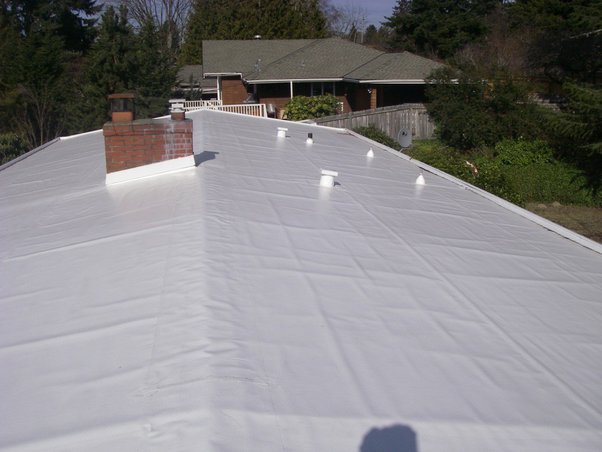
They say that ‘all good things must come to an end,’ but when it comes to PVC roofing, how long exactly does it last? While PVC roofs have gained popularity for their durability and energy efficiency–proper installation, regular maintenance, and quickly addressing any roof issues can also contribute to their longevity.
If you’re in the middle of a home construction or you’re deciding whether or not it’s time for you to change your roofing, this article will explain how long PVC roofs last and whether it’s a worthy investment for your property.
Benefits of PVC Roofing’s Longevity
PVC roofing’s impressive lifespan offers numerous benefits for homeowners and building owners. One of the main advantages is cost savings. With a longer lifespan than traditional roofing materials, such as asphalt or metal, PVC roofs require fewer repairs and replacements over time. This translates into significant savings on maintenance and labor costs.
PVC roofing’s durability also means that it can withstand harsh weather conditions, including high winds, heavy rain, and extreme temperatures. This reduces the risk of damage to the roof and the need for costly repairs or replacements.
Longevity is also beneficial in terms of sustainability. PVC roofing’s extended lifespan means less waste and fewer materials being sent to landfills, making it an environmentally friendly choice.
Not just that, PVC roofs often come with extended warranties, providing homeowners and building owners with peace of mind and protection against unexpected expenses.
Factors Affecting PVC Roofing Lifespan

Did you know that on average, PVC roofing can last between 20 to 30 years? With proper care and maintenance, some PVC roofs have been known to last even longer. It’s worthy to understand the factors that can affect the lifespan of PVC roofing, including environmental conditions, maintenance practices, and installation quality.
Environmental Conditions:
Extreme temperatures, UV radiation, and chemical exposure can all have an impact on the longevity of your PVC roof. Hot and cold weather can cause the material to expand and contract, which over time can lead to cracks and leaks. UV radiation from the sun can cause the PVC to deteriorate.
Therefore, if you live in an area with harsh climate conditions, the lifespan of your PVC roof may be shorter. Exposure to certain chemicals, such as oils or solvents, can also cause the roofing material to degrade more quickly.
Maintenance Practices:
This can also determine how long your PVC roof will last. Regular inspections, repairs and maintenance such as checking for leaks, and removing any mold or mildew can help identify and address any issues before they become major problems. Cleaning the roof regularly and removing any debris or standing water can also prevent damage and extend the lifespan of the PVC roofing.
The Quality of the Installation:
A poorly installed PVC roof can lead to leaks, premature aging, and reduced lifespan. Proper installation techniques, including correct seam welding and ensuring a secure attachment to the roof deck, can help prevent premature failures and extend the lifespan of the roof. It’s advisable to hire a professional roofing contractor who’s experience working with PVC roofing and can ensure proper installation techniques are followed.
Maintenance Tips to Extend PVC Roofing Lifespan
The lifespan of your PVC roofing can be extended by following these maintenance tips.
- Regular inspections are crucial to identify and address any potential issues early on. Check for any signs of damage, such as cracks, tears, or loose seams. Immediately repair or replace any damaged sections to prevent further deterioration.
- It’s advisable to clean your PVC roofing at least twice a year, using a mild detergent and a soft-bristle brush. Avoid abrasive cleaners or tools, as they can damage the surface. Regular cleaning helps remove debris, dirt, and algae, which can cause staining and affect the roof’s performance.
- Make sure that your gutters and downspouts are clear of any obstructions to allow proper drainage and prevent water buildup on the roof. Trim overhanging branches or vegetation that may cause damage or provide a pathway for pests.
- Consider applying a roof coating or protective layer to enhance the durability and longevity of your PVC roofing.
Comparing PVC Roofing to Other Roofing Materials
Comparing PVC roofing to other roofing materials helps in making an informed decision for your roofing needs. PVC roofing is known for its durability and longevity, making it a popular choice among homeowners and commercial property owners. When compared to other roofing materials such as asphalt shingles and metal roofs, PVC roofing has several advantages.
- Resistance to extreme weather conditions. It can withstand high winds, heavy rain, and even hail, without getting damaged. This makes it ideal for areas prone to severe weather.
- Highly resistant to fire. It has a high fire rating, which means it’s less likely to catch fire or spread flames. This can provide peace of mind knowing that your property is protected against fire hazards.
- Lightweight and easy to install. This can save you both time and money on installation costs. It’s also low maintenance, requiring minimal upkeep over the years.
- A cost-effective choice in the long run. In terms of lifespan, PVC roofing can last up to 30 years or more with proper care and maintenance.
Conclusion
PVC roofing is known for its long lifespan, typically lasting between 20 to 30 years. This durability is due to its resistance to extreme weather conditions, UV rays, and chemicals. With proper maintenance, PVC roofing can even exceed its average lifespan.
Overall, PVC roofing is a reliable and cost-effective choice for long-lasting protection for your property.
Steven Bennett
Related posts
Stay connected
Today's pick
- The Importance of Professional Handyman Services for Your HomeYour home is your sanctuary, a place of comfort and security, but maintaining it can be a daunting task. From routine maintenance to unexpected repairs, there’s always something that needs attention. While many homeowners might be tempted to tackle these jobs themselves, not all tasks... The post The Importance of Professional Handyman Services for Your […]
